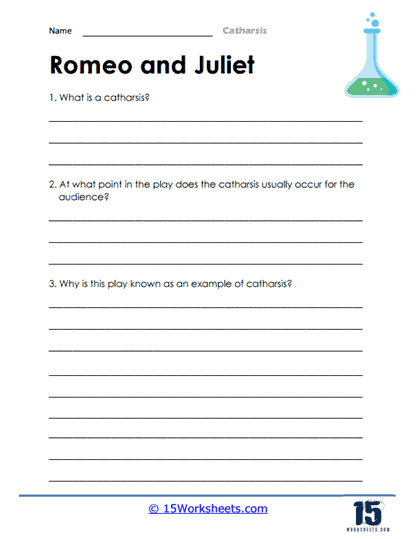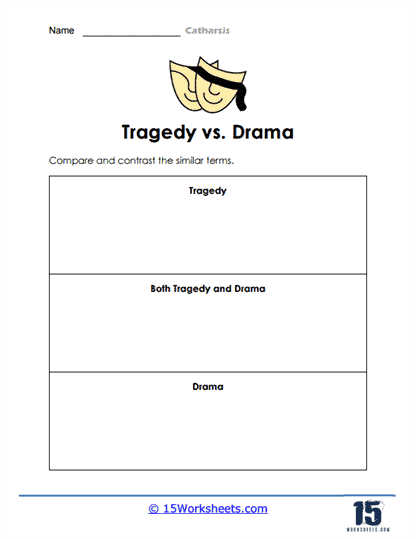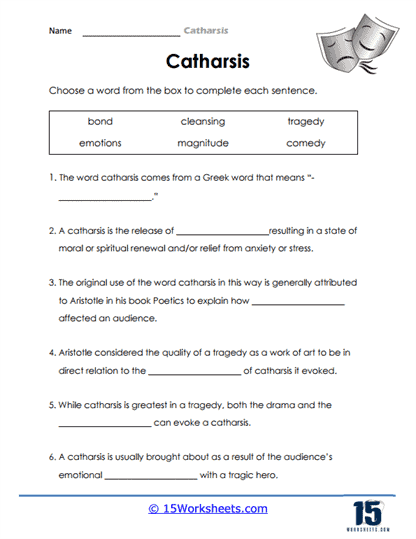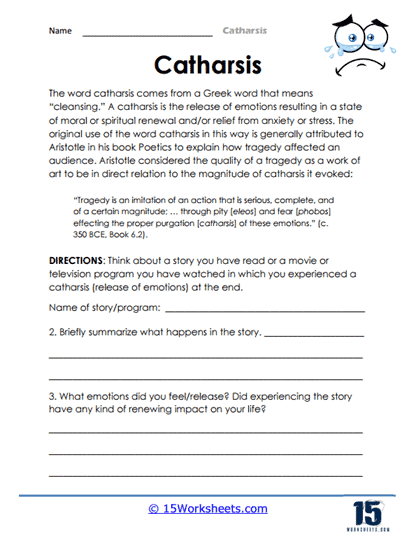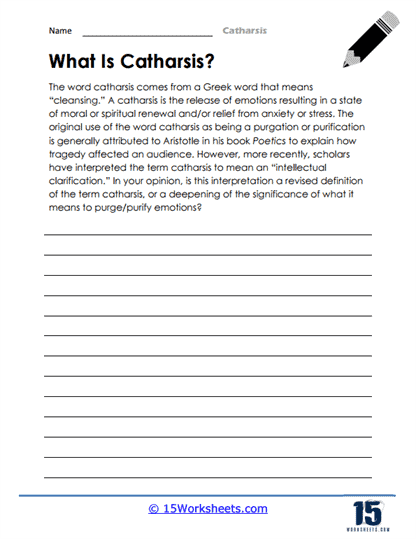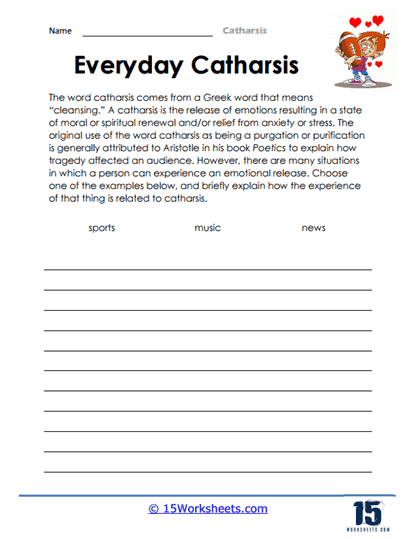Catharsis Worksheets
All About These 15 Worksheets
Catharsis, the emotional cleansing or release of pent-up feelings often achieved through artistic or dramatic experiences, is a profound and transformative aspect of human expression. Understanding and harnessing catharsis not only deepens a student’s emotional intelligence and empathy but also enhances their ability to navigate complex emotions and engage with literature and the arts.
In a world where emotional well-being, self-awareness, and creative expression are highly valued, students must develop the ability to recognize, analyze, and utilize catharsis to achieve emotional release and personal growth. To empower students with the knowledge of catharsis and its therapeutic and artistic applications, we proudly present a collection of 15 worksheets. These worksheets are meticulously designed to provide students with structured and engaging opportunities to explore, practice, and master the concept of catharsis.
The goal of these worksheets would be to help students identify instances of catharsis, understand the emotional journey that leads to it, and see how it contributes to the overall message or theme of a piece of literature.
Here are some exercises you might expect to see on these worksheets:
Identification – In this exercise, students might be given excerpts from plays, novels, or short stories, and asked to identify the moment of catharsis. Students would need to explain why they believe this moment represents catharsis and what emotions are being purged.
Since catharsis isn’t limited to written literature, students might be asked to watch a film or a TV episode and identify the moment of catharsis. This exercise could help students see how catharsis plays out in different types of storytelling.
Create Catharsis – Students might be asked to write their own short story or scene from a play that includes a moment of catharsis. This would help students understand how to build tension and emotion leading to a cathartic moment.
Analyze Catharsis – In this exercise, students could be asked to read a longer piece of literature, such as a play or a novel, and then write an essay analyzing the catharsis in the work. This would require a deep understanding of the characters, plot, and emotional journey in the work.
Connect to Personal Experience – Catharsis is ultimately about emotional release, something everyone has experienced. An exercise might ask students to write about a personal experience of catharsis. This would help students connect the literary concept to their own lives, deepening their understanding of it.
What is Catharsis?
Catharsis, a term derived from the Greek word “katharsis” meaning “purification” or “cleansing,” is a significant literary device often associated with dramatic literature. It was first identified by the ancient Greek philosopher Aristotle in his seminal work, “Poetics,” as the emotional effect a tragedy should have on its audience. Aristotle theorized that a well-crafted tragedy incites feelings of fear and pity in its viewers, ultimately leading to their emotional purification or relief—a process he termed “catharsis.”
The defining feature of catharsis is this emotional release experienced by the characters and/or the audience. It usually occurs towards the conclusion of a narrative, following a climax or critical moment of emotional tension. The cathartic moment often involves a transformative experience for the character, often a profound realization or intense emotional purging. For the audience, it signifies a release from the emotional buildup they’ve experienced alongside the characters, allowing them to achieve a sense of closure and satisfaction, and even moral or psychological insight.
Authors use catharsis to better engage readers, invoking strong emotional reactions and creating a connection between the reader and the narrative. It provides readers with a sense of resolution and satisfaction and offers them a chance to reflect on their own emotions, experiences, and morality.
Examples of Catharsis in Classic Literature
“Oedipus Rex” by Sophocles
In this classic Greek tragedy, the catharsis occurs when Oedipus, the king of Thebes, realizes that he has unwittingly killed his father and married his mother, thereby fulfilling the terrible prophecy that he had tried to avoid. Overwhelmed by this horrifying truth, Oedipus blinds himself. This is a moment of intense emotional purging for both Oedipus and the audience, releasing the accumulated tension and horror and leading to a feeling of pity and fear, thus achieving Aristotle’s idea of catharsis.
“Romeo and Juliet” by William Shakespeare
The catharsis in this tragic play comes with the deaths of the two young lovers, Romeo and Juliet. Their tragic end is a moment of intense emotional release, resolving the tension and conflict that has been building throughout the play. For the audience, their deaths evoke pity and fear and serve as a cautionary tale about the destructiveness of feuds and hasty actions, aligning with the concept of catharsis.
“The Kite Runner” by Khaled Hosseini
In this novel, the protagonist Amir has long been haunted by guilt over betraying his childhood friend, Hassan. The cathartic moment occurs towards the end of the story when Amir runs a kite for Sohrab, Hassan’s son-mirroring a happier time when Hassan did the same for him. In doing so, Amir feels a sense of redemption and release from his guilt, providing him and the readers with a profound emotional catharsis.
This technique serves as a crucial device in storytelling, facilitating emotional engagement, and providing closure. By successfully inducing catharsis, authors can create narratives that resonate deeply with their audience, leaving lasting impressions and insights. Understanding catharsis can enrich our reading experience and our emotional and moral engagement with a narrative, making it a powerful tool in the realm of literature.
The Importance of Understanding Catharsis For Students
Understanding catharsis and its various forms is of great importance for several reasons:
- Emotional Intelligence: Recognizing and engaging with catharsis enhances students’ emotional intelligence, helping them develop self-awareness and empathy for others.
- Therapeutic Value: Cathartic experiences, whether through art, literature, or self-expression, can serve as a healthy outlet for processing and releasing intense emotions, reducing emotional distress.
- Artistic Expression: Catharsis plays a crucial role in artistic and dramatic endeavors, allowing artists and performers to evoke powerful emotional responses in their audiences.
- Literary Analysis: Recognizing cathartic moments in literature and drama deepens students’ ability to interpret and discuss complex emotional themes in texts.
This collection of Catharsis worksheets is a valuable resource for educators and parents committed to nurturing emotional intelligence, self-expression, and creative engagement in students. Proficiency in recognizing, analyzing, and harnessing catharsis equips individuals with the tools to understand and manage their emotions, engage with art and literature on a deeper level, and experience the healing power of emotional release.
This collection is an investment in their future emotional well-being and creative potential, ensuring they have the skills to engage with their own emotions, empathize with others, and engage with the arts as a transformative force in a world where emotional resilience and creative expression are valued assets. Explore these worksheets today, and watch your students become emotionally aware, empathetic, and creatively empowered individuals who can navigate the complex landscape of human emotions with insight and grace.



